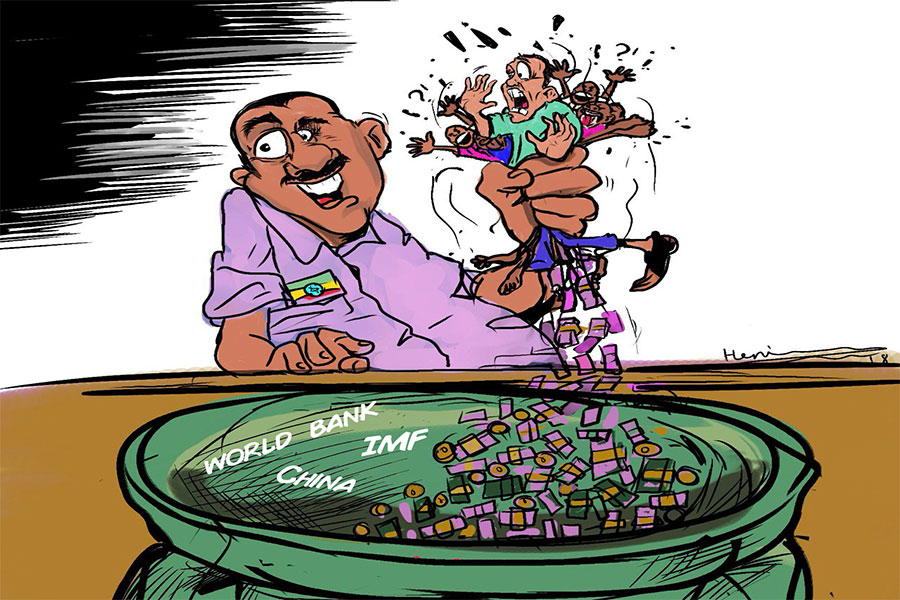
Radar | Oct 30,2021
Dec 19 , 2018
By Ameha Tefera
A novel way of avoiding a liquidity crunch and credits risks for banks is to adopt interest rate commission agent banks. Through these agents, investors could directly finance entrepreneurs, with interest rate commissions flowing to banks and loans being traded on markets, argues Ameha Tefera (ambet22002@yahoo.com), an employee at Commercial Bank of Ethiopia who has published banking research articles.
The banking business has been in an upward trajectory for the past couple of years, despite the regressive policies of the National Bank of Ethiopia, most of them enacted to protect against inflationary risks.
Although there is little worry of a liquidity crunch or systemic credit risk in the banking system currently, banks must consider their options ahead of such crises.
This can be done by applying a system of agent banking for interest rate commissions.
This is when a loan is disbursed from an investor’s account, rather than the bank's, into that of an entrepreneur’s deposit account. No savings interest is paid on the loan disbursed and the bank collects non-volatile and uninterrupted interest rate commissions from the investor’s loan funding credit price until loan settlement. This can improve profitability and sustainability.
Since the system totally transfers bank credit and liquidity risks to the investor and entrepreneur, the bank is never expected to encounter credit risk, liquidity risk or interest rate risk. To adopt this, banks should develop three lending strategies.
The first strategy involves an investor and entrepreneur who know each other and an agent bank. The investor and entrepreneur go to the agent bank at the same time. An investor can fund a loan for an entrepreneur by selecting an entrepreneur’s project from the market or through an agent bank with or without pledging the entrepreneur’s collateral.
Should an investor wish to collect the funds disbursed to entrepreneurs, the agent bank sells the loan to another investor who has the interest to invest in the entrepreneur’s business.
Similarly, should the entrepreneur fail to pay as agreed, the agent bank rents the business to another entrepreneur who has the capacity to manage the business and to settle the loan without having ownership of the business.
However, ownership can be transferred to the second entrepreneur by the will and approval of the investor and the bank. Therefore, the loan revolves from investor to entrepreneur, and until it is settled, the bank collects an interest commission from the investor.
A second strategy involves an investor and an entrepreneur who do not know each other nor the bank. The investor and entrepreneur each go to the agent bank at different times. With this lending strategy, an agent bank selects an entrepreneur’s project and finances it through an investor.
In selecting an entrepreneur’s project, the bank charges an investor a project selection fee. In this case, investor loan funding requires pledging collateral to ensure that the bank collects the disbursed funds if the entrepreneur fails to repay the loan.
The last lending strategy involves the fund provider and the bank. With this lending strategy, the fund provider deposits money and later shifts all or part of it to fund the entrepreneur’s project through an agent bank to collect the partial or full credit price. When the depositor moves to the investor position, the bank becomes an agent bank for the investor, since the depositor’s funds have already been invested by the bank.
To increase the sustainability of the banking business, the bank that works as an interest rate commission agent is important for several reasons. It enhances stability, decreases the informal money market, attracts funds from the unbanked and informal financial market and enables depositors to benefit from the credit price, instead of the deposit interest rate.
It would also enable the bank to transfer credit risk to the fund holder and investor, so that banking crises are mitigated and societal awareness of the banking system is increased.
It also increases the contribution of banks and society in development by allowing individuals to search for potential entrepreneurs to lend their funds to with the bank as an agent.
These lending strategies enable the agent bank to transfer credit and liquidity risks to investors and entrepreneurs. The main target is to produce a sufficient ecosystem of investors and entrepreneurs in society to grow the economy.
The increase of investment in a country increases per capita income. Since the cash flow in alternative investment solutions circulates from investor to entrepreneur, the potential of unbanked members of society to participate in this system would be high.
An entrepreneur is nominated either by an investor or by the agent bank, the latter of which assesses the loan administration skill of the person that wants credit. Should the skill of an entrepreneur be found lacking, the agent bank should be able to design the business plan for the new project with the support of the entrepreneur to reduce credit and operational risk.
An agent bank processes investors loan funding and administers the loan after disbursement to generate non-interest income. This is done while investors and entrepreneurs are present at their selected agent bank to transact a loan with or without pledging the entrepreneur's collateral. The loan repayment is collected in the loan period from the entrepreneur's and sent to the investor's account.
Banks grant long-term loans based on short-term deposits, which could bring about a liquidity crunch and credit risks. The agent bank avoids contagious credit and liquidity risks by transferring them to investors and entrepreneurs. It develops a culture of lending, borrowing and saving as a mutual benefit to the investor, entrepreneur and the bank.
Since the model works with other banking business models according to the organisation’s incentive structure and culture, it protects the bank and fund provider from permanent banking risks where other business models fail. Since the agent bank collects interest rate commissions up to loan settlement, bank commission income is uninterrupted as it does not hold the depositor’s funds as its own asset.
Agent bank profitability increases as its interest rate commission and fees for loan administration increase.
The bank that adopted the system can mobilize deposits by applying discrete interest incentives according to deposit levels. It could later let depositors move to the investor position to benefit credit prices, instead of paying them interest on their savings.
The market for loan transactions can be capital market or money market according to the loan period. If the loan period stated in the loan contract is less than a year, the agent bank can sell the loan, which an investor requests to withdraw, in the money market without issuing a security.
Instead of issuing financial securities, the agent bank amends the loan contract by including a new entrant investor. If the loan period in the loan contract is more than a year, the agent bank sells the loan in the capital market without issuing securities but amending the loan contract by including the new entrant investor.
The loan transaction market can finance national and international trade. A loan transaction market helps the industry in securing short-term as well as long-term loans while enabling the agent bank to be highly liquid. The loan interest rate set in the loan contract by agreement of the agent bank, investor and entrepreneur serves the central bank as an indicator of monetary and banking conditions in the country.
The loan transaction market therefore enables the central bank to implement appropriate banking policy in accordance with current market characteristics. Done the right way, this could provide a win-win scenario for entrepreneurs, investors, the banking industry and the economy.
PUBLISHED ON
Dec 19,2018 [ VOL
19 , NO
973]


Radar | Oct 30,2021

Sponsored Contents | Jul 05,2021

Fortune News | Oct 24,2020

Radar | Nov 23,2019

Radar | Sep 22,2024

Fortune News | Jul 28,2024

Radar | Jun 01,2019

Radar | Dec 25,2021

Radar |

Commentaries | Sep 01,2024

Photo Gallery | 175840 Views | May 06,2019

Photo Gallery | 166058 Views | Apr 26,2019

Photo Gallery | 156461 Views | Oct 06,2021

My Opinion | 136846 Views | Aug 14,2021

Dec 22 , 2024 . By TIZITA SHEWAFERAW
Charged with transforming colossal state-owned enterprises into modern and competitiv...

Aug 18 , 2024 . By AKSAH ITALO
Although predictable Yonas Zerihun's job in the ride-hailing service is not immune to...

Jul 28 , 2024 . By TIZITA SHEWAFERAW
Unhabitual, perhaps too many, Samuel Gebreyohannes, 38, used to occasionally enjoy a couple of beers at breakfast. However, he recently swit...

Jul 13 , 2024 . By AKSAH ITALO
Investors who rely on tractors, trucks, and field vehicles for commuting, transporting commodities, and f...

Oct 18 , 2025
The political establishment, notably the ruling party and its top brass, has become p...

Oct 11 , 2025
Ladislas Farago, a roving Associated Press (AP) correspondent, arrived in Ethiopia in...

Oct 4 , 2025
Eyob Tekalegn (PhD) had been in the Governor's chair for only weeks when, on Septembe...

Sep 27 , 2025
Four years into an experiment with “shock therapy” in education, the national moo...

Oct 18 , 2025 . By NAHOM AYELE
In a sweeping reform that upends nearly a decade of uniform health insurance contribu...

A bill that could transform the nutritional state sits in a limbo, even as the countr...

Oct 18 , 2025 . By SURAFEL MULUGETA
A long-planned directive to curb carbon emissions from fossil-fuel-powered vehicles h...

Oct 18 , 2025 . By BEZAWIT HULUAGER
Transaction advisors working with companies that hold over a quarter of a billion Bir...